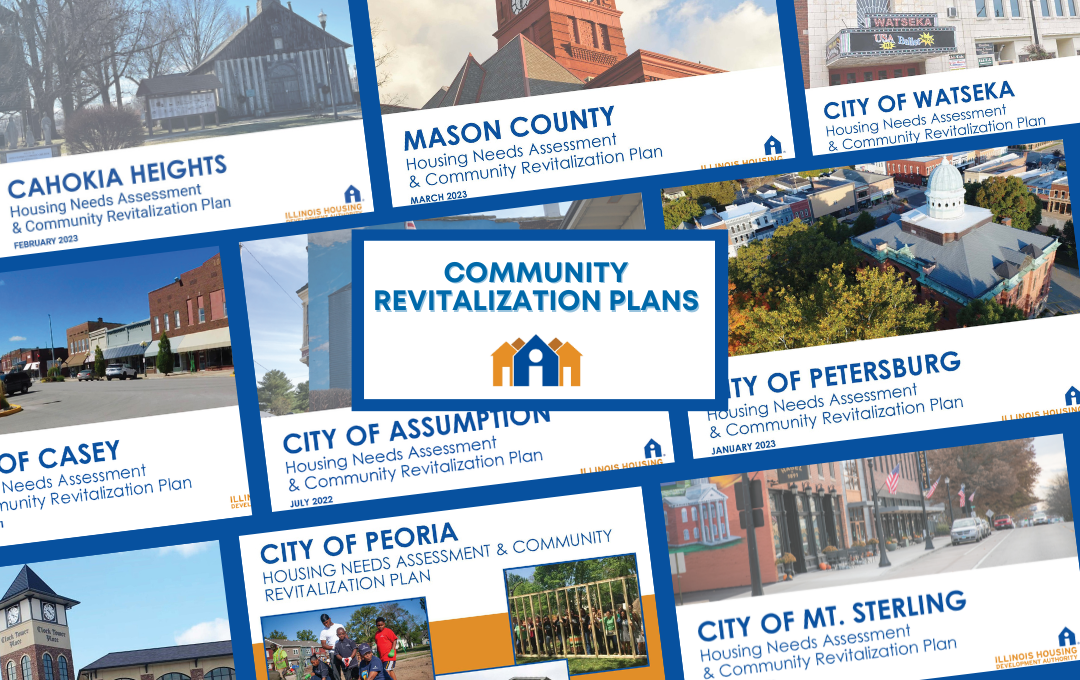Community Revitalization Plans
Community Revitalization Plans
The Illinois Housing Development Authority (IHDA) is committed to expanding the capacity of communities in Illinois to identify local housing needs and to empower those communities to take steps to meet those needs. As a part of this commitment, IHDA enters into partnerships with smaller and rural communities throughout the state to assist them in undertaking a local planning process that builds upon and links to existing planning and development efforts, identifies strengths and needs within the community, and generates localized capacity via a Community Revitalization Strategy process. This process may result in increased local capacity to connect housing and economic development and community goals, and bring affordable housing to areas throughout the state by helping communities to minimize barriers of access to housing development tools.
By undertaking a Community Revitalization Strategy endeavor with IHDA, partnering communities may proactively increase their own capacity on multiple fronts. Primarily, they will be contributing to the expansion of local leaders’ and residents’ capacity to plan for a variety of affordable housing opportunities as the community grows. Additionally, housing developers and investors will benefit by being able to connect to and potentially utilize the market analysis tools and funding sources identified by this process to strategically align their plans with the community’s for developing affordable housing.
As a part of developing a participatory-driven and comprehensive Housing Needs Assessment, IHDA provides technical assistance to the partner community to bring together various data sources, organize community members and stakeholders, and evaluate the conditions and needs of the community to inform the final plan produced here.
The Housing Needs Assessment is a product that the community may use to inform its future plans for affordable housing as it fits within broader community development. The plan includes a variety of data sources; a guide to IHDA resources, programming, and terminology; community overviews that highlight the community’s demographic, economic and housing conditions; and an analysis of the area’s market as viewed from a housing finance authority lens. It also includes: results and feedback gathered from community participation and the Community Needs Assessment Survey; a Housing Stock Survey that provides various characteristics of the area’s building stock, including the exterior conditions of its housing; and finally, a list of active incentive zones as well as other resources that may be of use to the community in carrying out their plans for future development. Appendices may include additional materials to support the community’s understanding of resources, government policies and incentive activities, past plans, and IHDA programming available within their community.
You may view and download each of the following plans by clicking on the city links below. If you wish to download all of the plans at once, please click here.
- Mt. Vernon: The City of Mount Vernon is located in Jefferson County in the southern part of Illinois. This Housing Needs Assessment looked at community needs in the entire city with special attention to the South Town neighborhood which is made up of Census Tracts 509 and 510. The plan was completed in August of 2023 in partnership with the Housing Authority of Mt. Vernon.
- Sauk Village: Sauk Village is located in the Southeast suburbs of Chicago bordering Indiana. This Housing needs assessment included a housing stock survey, community needs assessment survey, and public meetings to identify the needs of Sauk Village in regard to housing and development opportunities. The plan was completed in May of 2023.
- Erie: The Village of Erie designated the entire municipality of approximately 1,700 people as its community revitalization strategy area. Located in Whiteside County in northwest Illinois, the community has a high median income and great schools, but is lacking in quality affordable rental housing to help support those schools and new restaurants in town. The Village adopted this Housing Needs Assessment and Community Revitalization Plan in April 2023.
- Watseka: The City of Watseka, county seat of Iroquois County, is located in Eastern Illinois along the Iroquois River. The entire City of Watseka was designated as the community revitalization strategy area for this study. With its approximately 4,900 residents, Watseka has seen a population decrease in recent years and is dedicated to improving housing stock and improving quality of life of its residents through economic and community development. The City Council adopted this Community Revitalization Plan in April 2023.
- Mason County: Mason County is located in Central Illinois, constrained by the Illinois River to the west and the Sangamon River to the south. All of Mason County, with a particular focus on the two municipalities of Havana and Manito, was designated as the community revitalization strategy area for this study. The county has many assets, including multiple state recreational sites and historic downtown districts. This study was commissioned by Praireland Community Development on behalf of the county.
- Cahokia Heights: The Southern Illinois Healthcare Foundation (SIHF) and the St. Clair County Housing Authority (SCCHA) formed a partnership with IHDA to revitalize the newly formed City of Cahokia Heights, created by ballot merger of the communities of Cahokia, Alorton, and Centreville in 2021. The partners designated the entire municipality as the community revitalization strategy area for this study, but focused on Census Tract 5028, where Touchette Regional Hospital is located in an extremely disinvested community that suffers from extensive and chronic health needs partially due to crumbling housing and infrastructure. Touchette Regional Hospital adopted this Housing Needs Assessment and Community Revitalization Plan as part of its overall transformation and revitalization plan in February 2023.
- Petersburg: The City of Petersburg, located in the Springfield metro area in Menard County, designated the entire municipality as its community revitalization strategy area for this study. Home to Lincoln’s New Salem Historic Site, Petersburg has a historic downtown and is working to revitalize the square and its existing affordable housing to support its burgeoning tourism industry. The City Council adopted this Housing Needs Assessment and Community Revitalization Plan in January 2023.
- Jacksonville: The City of Jacksonville adopted this plan on January 9, 2023 after a presentation to the council and considerable public comment. A 2023 9% tax credit was awarded to a development in Jacksonville that used this plan at application as part of the evidence for scoring.
- Macomb: The City of Macomb, home to Western Illinois University (WIU), designated three target areas as Community Revitalization Strategy Areas for this study, focusing the plan’s activities on engaging residents and examining conditions with three of four broad “quadrants” central to the city’s core. IHDA surveyed students at WIU as part of this study to gain the fullest understanding of the issues facing Macomb, including housing affordability and housing quality. Macomb’s City Council adopted the Housing Needs Assessment in October 2022.
- Assumption: The City of Assumption, located south of Decatur in Christian County along Illinois Rt. 51, designated the entire municipality as the Community Revitalization Strategy Area for this study. This city of about 1,100 people is home to major employers such as GSI Group and Sloan Implement, and is hoping to revitalize its downtown area with mixed use housing to complement new businesses such as the 1905 Brewing Company. The City Council adopted this Housing Needs Assessment and Community Revitalization Plan in September 2022.
- Gillespie: The City of Gillespie designated the entire municipality as its community revitalization strategy area for this study. Gillespie is located along the historic Route 66 and is preparing to kick-off a major downtown streetscaping project. Once a thriving coal mining town, the city aims to modernize their housing stock and improve the vitality of their downtown corridor. The City Council adopted the Housing Needs Assessment in June 2022.
- Marion: The City of Marion designated the Midway Court neighborhood as its community revitalization strategy area for this study. The area had been developed as temporary workforce housing during World War II and had suffered serious disinvestment due to poor platting and infrastructure. The City Council adopted the Housing Needs Assessment in April 2022.
- Mt. Sterling: The City of Mt. Sterling designated the entire community as a revitalization strategy area. For the first time, IHDA surveyed commuters to Dot Foods, the area’s largest employer, in addition to Mt. Sterling residents, in order to determine whether employees who live elsewhere might be amenable to moving to Mt. Sterling. The housing needs assessment was adopted by Mt. Sterling City Council in November 2021.
- Calumet Park: Due to a plethora of planning resources in the Chicago Metro region, IHDA’s community revitalization team does not typically engage in full planning partnerships with communities in the 7-county Chicagoland area, but we are able to offer individual services to communities that other planning agencies are not able to offer themselves, such as a housing stock survey. That is the case for Calumet Park, a city in Chicago’s south suburbs, where the team completed a housing stock survey for the entire municipality in partnership with the Homes for a Changing Region program staff in late summer of 2021.
- Casey: The City of Casey designated the whole municipality as the community revitalization strategy area. The tourism industry is booming due to local business support of the “Big Things, Small Town” campaign, and upgraded housing is needed. This community revitalization strategy was adopted by the Casey City Council in October 2021.
- Peoria: Three neighborhoods were chosen by the City of Peoria for this initiative: Near Northside, East Bluff, and Near Southside. The Housing Needs Assessment evaluated each neighborhood separately and offers goals and recommendations for each. The City of Peoria adopted this plan in the spring of 2021 after considerable public comment, and a housing developer was allocated Low Income Housing Tax Credits in 2020 based partly on the strength of this planning document.
- East Peoria: The City of East Peoria designated three neighborhoods as community revitalization strategy areas: Richland, Kroger, and East Peoria High School. The Housing Needs Assessment evaluated each neighborhood separately and offers goals and recommendations for each. This community revitalization strategy was adopted by East Peoria City Council in March 2021.
To start the Community Revitalization process, reach out via email to Revitalization@IHDA.org or read more at the Getting Started with Community Revitalization page.



















